Mastering Wind Direction Meters for Watersports
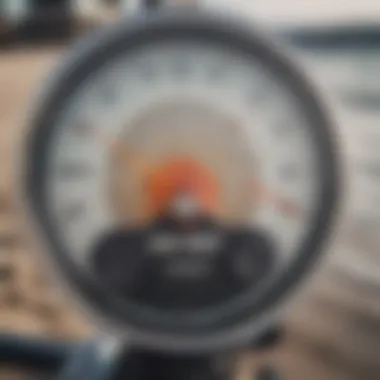
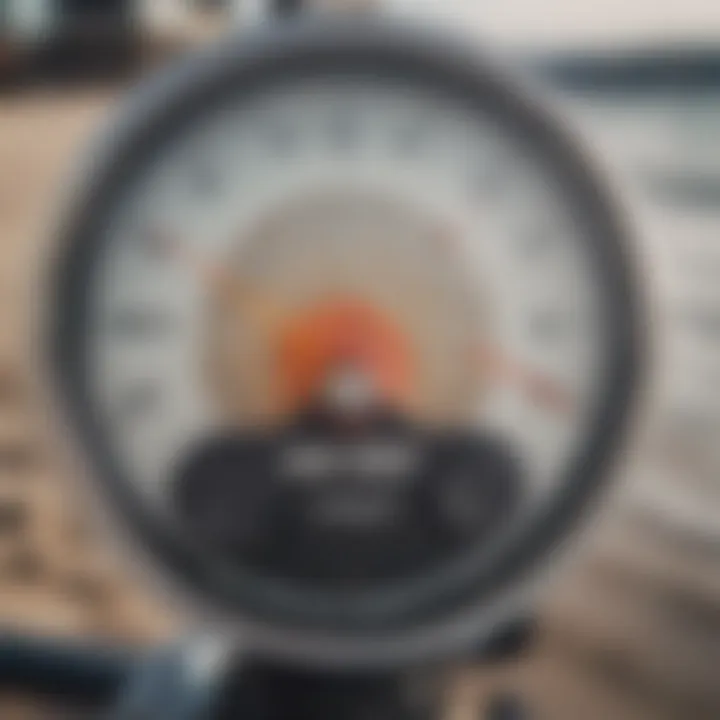
Intro
In the world of watersports, understanding wind dynamics is essential for both performance and safety. Imagine you're on a sailboat, feeling the wind in your hair, and steering towards the horizon. Your success hinges not only on your skill but also on your ability to read the wind. This is where wind direction meters come into play. They’re more than just fancy gadgets; these tools are vital for anyone keen on enhancing their time on the water.
Why Wind Direction Matters
When you’re out there battling the elements, the wind can be a friend or foe. It influences speed, direction, and overall control. Misjudging the wind could lead to paddling against a strong current or capsizing in unexpected gusts. Wind direction meters essentially act as your guiding compass, allowing you to make informed decisions while enjoying activities such as sailing, kitesurfing, or paddleboarding.
But have you ever stopped to think about how these meters work or which type might suit you best? Throughout this article, we’ll explore the nuances of wind direction meters and unravel how they contribute to a superior watersports experience.
Prologue to Wind Direction Meters
Wind direction meters play a pivotal role across various watersports. An athlete, whether they are sailing, surfing, or even kayaking, must have a keen understanding of wind behavior to optimize their performance on the water. Knowing which way the wind blows isn't just about feeling the breeze on your face; it’s a game changer in competitive contexts and leisure activities alike. This section shines a light on why mastering wind direction measurement can elevate an individual’s experience on the water.
Defining Wind Direction Meters
When we talk about wind direction meters, we refer to instruments specifically designed to measure the direction from which the wind is blowing. These devices come in varied shapes and features, catering to different activities and preferences. For instance, a mechanical wind vane resembles a simple flag that turns with the wind, whereas digital anemometers provide more precise readings through electronic sensors.
Wind direction meters usually offer crucial information in angular degrees rotation from north, aiding performers in adjusting their tactics according to changing wind patterns. This measurement is essential not only for sailing but also for other wind-powered sports like kitesurfing. Having instant access to accurate wind data can influence decisions like when to catch a wave or make the perfect turn.
Historical Context and Development
The concept of measuring wind direction can be traced back several centuries. In ancient maritime history, sailors would observe the behavior of smoke from fires or the movement of flags and sails to determine wind direction. As technology progressed, so did the methods for wind measurement.
The introduction of the anemometer by Leon Battista Alberti back in the 15th century marked a pivotal turn in accurately quantifying wind speed and direction. Over the years, variations have been refined—modern applications include digital sensors and smart technology that give real-time updates via connected devices. This evolution has made wind measurement not just a matter of necessity but also an affordable and accessible aspect of recreational and competitive watersports.
By understanding these tools and their history, watersports enthusiasts can appreciate how far we’ve come and how crucial wind direction meters are in mastering their craft.
The Science of Wind and Its Direction
Understanding wind and its direction plays a crucial role when it comes to watersports. Winds are not just fleeting gusts; they mold the water’s surface, influence currents, and dictate the overall environment in which various water activities occur. For enthusiasts—be it sailors, surfers, kitesurfers, or kayakers—being in tune with wind patterns can spell the difference between a mediocre outing and an extraordinary adventure.
When diving deep into the science of wind, it’s vital to grasp how it forms, how patterns develop, and how such nuances impact performance. Knowledge of wind dynamics enables athletes to make informed decisions, optimizing their gear setups and routes.
Wind Formation and Patterns
Wind originates from the uneven heating of the Earth's surface by the sun. This causes temperature variations which, in turn, create areas of high and low pressure. Air flows from high-pressure areas to low-pressure ones, generating wind.
Key factors influencing wind patterns include:
- Geography: Mountains, valleys, and bodies of water change how wind moves.
- Seasonal Changes: Different times of the year bring varying wind conditions.
- Local Weather Systems: Fronts and storms can drastically modify existing patterns.
Recognizing these elements helps watersports enthusiasts predict conditions. If you're out sailing and those dark clouds roll in, being armed with this knowledge can alert you to potential changes in wind speed and direction.
Measuring Wind Direction Accurately
Accurate measurement of wind direction hinges on various key variables; understanding them empowers athletes.
Key Variables Affecting Wind Direction
The primary aspect affecting wind direction is topography. Elevation changes like hills and trees create turbulence, altering the wind’s course. Monitoring these variables is not just beneficial; it’s essential for making tactical adjustments on the water. For instance, a well-placed wind direction meter can help identify how much a nearby obstacle is affecting wind flow, providing a clearer picture for sailors.
Another significant factor is wind speed. Seems simple, right? But wind speed can cause dramatic shifts in direction. Fast-moving winds tend to follow a straighter path, while slower winds may wander unpredictably.
A unique feature of this variable is its direct interaction with sailing performance. As winds increase in speed, they often veer slightly, which can be advantageous for adept sailors who can harness this change to gain an edge in races. However, it can be a double-edged sword if not carefully monitored.
Understanding Magnetic vs. True North
Understanding the difference between magnetic north and true north is essential when measuring wind direction. Magnetic north refers to the direction that a compass points, aligning with the Earth's magnetic field. True north, conversely, is a fixed point based on the Earth's geography.
This distinction is crucial for accurate navigational readings in watersports. A common misconception is that compasses always align perfectly with true north, but they can be off by a degree or more depending upon your location on the planet. The amount of declination varies even from place to place!


When sailing or navigating in unfamiliar waters, relying solely on magnetic readings can cause errors. For example, if your wind vane indicates a wind direction based on magnetism without accounting for true north, you risk miscalculating your heading, which can lead you awry during your adventure.
In sum, comprehending the nuances between magnetic and true north not only enhances navigation accuracy but also enriches the experience, allowing watersports enthusiasts to engage more deeply with their surroundings.
"Understanding wind direction is like knowing the rules of the game; it's what ultimately determines your success on the water."
Types of Wind Direction Meters
When it comes to watersports, knowing the wind direction is paramount for maximizing performance and ensuring safety. Hence, understanding the different types of wind direction meters is crucial for athletes and enthusiasts alike. Each type offers its own unique features, advantages, and applications, making it necessary to assess what aligns best with one’s specific watersport needs.
Mechanical Wind Vanes
Mechanical wind vanes are the classic choice for monitoring wind direction. They are sturdily built, often made from lightweight materials like aluminum or molded plastic. These devices work based on simple mechanics; a rotating arm or blade moves in response to the wind, allowing the user to read the indicated direction on a dial or compass.
One of the key benefits of mechanical wind vanes is their durability. They are less susceptible to damage compared to electronic devices, making them a favorable option for rocky coastlines or rugged conditions. Another notable strength is the low maintenance requirement—these tools don’t need batteries and are less prone to malfunction due to electronic failures.
However, they do come with some limitations. Their accuracy can drift, and they usually require calibration, especially after exposure to harsh weather. Also, reading wind direction requires a clear view of the scale, which might not always be feasible in inclement weather or high-stress situations.
"Mechanical wind vanes offer a reliable, low-tech way to measure wind direction, but their accuracy hinges on proper calibration and conditions."
Digital Anemometers
Digital anemometers represent a significant step forward in wind measurement technology. These devices typically feature a digital display that gives real-time readings of wind speed and direction. They often come equipped with advanced features like data logging, connectivity options for smartphones, and even alarms for certain wind conditions.
A digital anemometer’s primary advantage lies in its precision. These instruments utilize advanced sensors to deliver accurate and instant readings, which can be invaluable in fast-paced watersports. They often include user-friendly interfaces, allowing for quick adjustments and settings tailored to the specific activity—be it kayaking, sailing, or surfing.
Yet, all that glitters isn’t gold. Digital anemometers require batteries and can be sensitive to their environment. Over time, exposure to saltwater and humidity may impair functionality or lead to corrosion. Moreover, while generally easy to use, the sheer number of features might overwhelm novices who prefer straightforward operations. Adapting to new technology can present a learning curve.
Smart Wind Sensors
Smart wind sensors are the newest addition to the lineup of wind direction meters, set apart by their integration into the Internet of Things (IoT). These sensors can connect seamlessly with mobile devices, delivering wind data right to an app or interface on your smartphone. Advanced models can even provide weather forecasts and real-time alerts for changing wind conditions.
The key benefit of smart wind sensors is their convenience and versatility. For instance, a kitesurfer could monitor wind conditions from the comfort of their beach towel instead of running to check a physical meter. Plus, the ability to store and analyze historical data can help users identify patterns and improve their performance over time.
Nonetheless, the reliance on technology must be taken into account. Smart wind sensors depend on a stable power source and may struggle to function properly in extreme environments. As with digital anemometers, issues can arise related to battery life and maintenance. Some models can be pricey compared to their mechanical counterparts, and users must often update software or make sure their devices are connected to the internet to access full features.
In summary, the choice of wind direction meter should hinge on your specific needs, sailing conditions, and personal preferences. Understanding the distinctions could mean the difference between a thrilling day on the water and one filled with unnecessary difficulties.
Applications of Wind Direction Meters in Watersports
The significance of wind direction meters in watersports cannot be overstated. These devices serve not just as simple gadgets but rather play a pivotal role in enhancing performance and safety for participants across various aquatic activities. Understanding the application of these meters helps athletes and hobbyists alike to fine-tune their tactics, ensuring they make the most out of their experiences on the water.
Sailing Performance Optimization
When sailing, the wind directions directly influence the choice of sail trim and course. A sailor equipped with a reliable wind direction meter can strategize more effectively by adjusting their sails in real-time, utilizing gusts and lulls to their advantage. A device that gives precise readings simplifies this process significantly.
- Optimal Sail Management: Knowing how the wind shifts can aid in setting the sails to maximize speed and minimize drag.
- Tactical Movements: In competitive sailing, understanding wind patterns can mean the difference between winning and losing. Predictions based on reliable data can lead to better positioning relative to competitors.
Using tools like the Davis Instruments 07100 Vantage Vue allows sailors to get wind readings and predict their best routes. The goal is to make every tack and jibe count, especially in areas notorious for changing winds, such as coastal waters.
Surfing Forecasts and Conditions
In surfing, conditions can change quickly, and wind direction plays a critical role in shaping wave quality. A wind direction meter can inform surfers about the most suitable times to ride the waves.
- Understanding Swell Direction: Knowledge of wind patterns assists surfers in locating the optimal spots for catching smoother and faster waves.
- Preventing Capable Issues: High winds can wreak havoc on wave formation. By being aware of wind speeds and directions, surfers can avoid potentially dangerous conditions.
Devices like the Kestrel 5500 Weather Meter, which measure wind flow intimately tied with wave formation, help surfers to navigate thrilling yet safe experiences.
Kitesurfing and Wind Accuracy
Kitesurfing demands a different level of precision due to the dynamic interactions between the rider, the kite, and the wind. Wind direction meters can aid kitesurfers in maintaining control over their kites.
- Enhancing Control: Different wind directions can affect how well the kite lifts and how stable it is in the air. Knowledge of the wind's behavior can lead to improved responsiveness and control from the rider.
- Safety and Predictability: Kitesurfers need to remain alert to changing wind patterns, especially when riding near others. Thus, using devices that accurately report wind conditions ensures a safer riding environment.
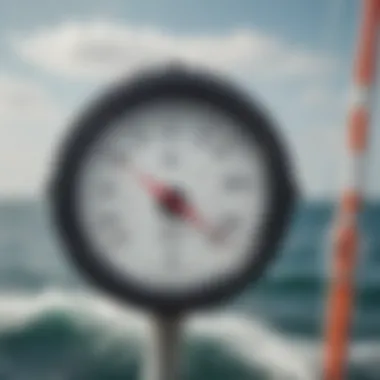
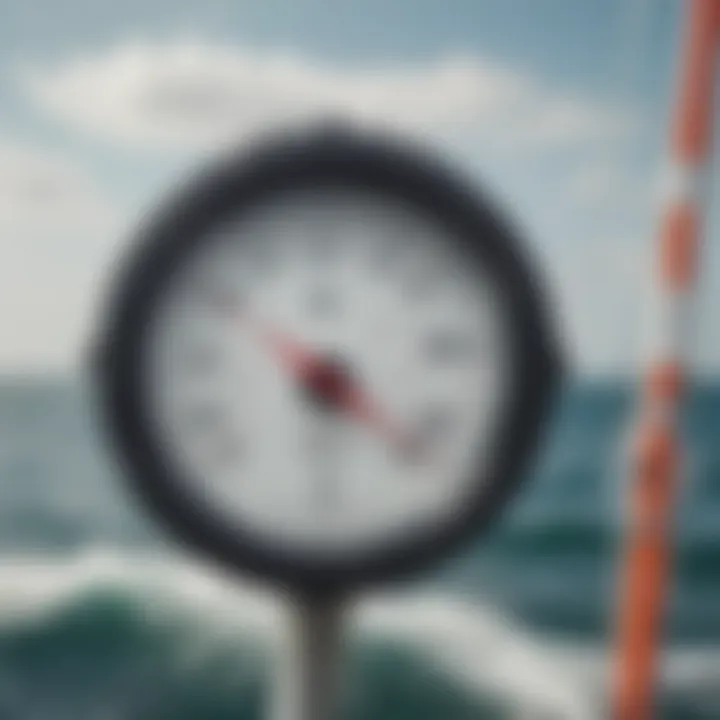
Quality products like the Wind Meter by Anemometer provide real-time data necessary for experienced and novice kitesurfers alike, aiding them in gauging their surroundings.
Kayaking Considerations
For those kayaking, wind direction is just as crucial, often affecting the paddling effectiveness and enjoyment level on the water. A clear understanding of wind patterns can turn a grueling workout into a pleasant adventure.
- Paddling Efficiency: Knowing the wind direction can decrease paddling resistance or enhance it, depending on whether one is moving upstream or downstream.
- Planning Routes: Paddlers can plan their routes better to minimize struggle against headwinds and can take advantage of tailwinds to speed up their journey.
The Garmin inReach Mini, which combines GPS tracking with wind direction tools, offers kayakers the edge they need to feel confident while navigating their routes.
"Understanding wind direction can mean the difference between a fun day on the water and a challenging experience. A little knowledge goes a long way in watersports."
Arming oneself with a wind direction meter not only enhances performance but also adds a layer of safety across all these watersports. Making the informed choice about conditions leads to more thrilling escapades without unnecessary risks.
Importance of Accurate Wind Measurements
When it comes to watersports, getting the wind measurements just right can mean the difference between an exhilarating day on the water and a frustrating experience. Accurate wind measurements are not just numbers on a dial; they are critical data points that influence every aspect of a sport, from performance to safety.
Safety Implications
In the realm of watersports, safety can never be overemphasized. Wind conditions can change rapidly, which is why having precise and timely wind direction readings is crucial. If a sailor or kitesurfer misreads an unexpected gust of wind, it could lead to capsizing or losing control. For instance, an experienced sailor out on Puget Sound who doesn't account for shifting wind could be caught off guard by sudden turbulence, potentially leading to an accident. Moreover, strong winds can create rogue waves. Without accurate wind data, participants may underestimate the risks, putting themselves and others in peril.
Here are some safety aspects to consider:
- Recognizing Wind Strength and Direction: Knowing which way the wind blows and how strong it is can help individuals make crucial decisions about whether to head out or turn back.
- Understanding Local Weather Patterns: Every body of water has its unique microclimates. Accurate wind measurements can help understand these local phenomena, reducing the risk of surprises.
- Responsive Equipment Use: Having immediate access to wind data allows for equipment adjustments, ensuring that gear matches current conditions.
"Safety is not a gadget, but a state of mind."
Performance Enhancement
Achieving optimal performance in watersports relies heavily on knowing the wind’s mood. When participants accurately interpret wind direction, they can steer their boards or sails more effectively, carving paths that harness natural forces instead of fighting against them. Think of a kayaker navigating downriver: aligning their movement with wind patterns can lead to not only smoother rides but also better speed and agility.
Additionally, athletes can perform optimally in competitions by leveraging wind data:
- Strategic Positioning: Windsurfers and sailors can find the best positions to gain advantages over competitors. Understanding wind direction allows them to choose when and where to tack or jibe, making swift maneuvers.
- Efficiency in Training: By using accurate wind measurements during practice, athletes can refine their skills. They can learn to adjust their techniques based on various wind conditions, which prepares them for unpredictable race day scenarios.
- Utilizing Technology: Modern wind direction meters, such as smart sensors, provide real-time analytics. This not only enhances performance but also gives an edge in understanding how to adapt swiftly to changing conditions.
Choosing the Right Wind Direction Meter
Selecting the correct wind direction meter can make or break your experience on the water. The right tool doesn't just offer readings; it shapes your strategy and enhances performance. Whether you are sailing in a regatta, surfing on a windy day, or simply enjoying a day of fishing, understanding the essential features and considerations is crucial. A good selection process ensures you get the most out of your time spent on the water, helping you to embrace every breeze and gust with confidence.
Key Features to Consider
Range and Accuracy
When it comes to wind direction meters, range and accuracy are non-negotiables. The range refers to the span of wind conditions that the meter can effectively measure, while accuracy speaks to how closely the readings reflect real conditions. If a device can’t handle the wind speeds typical in your watersport activity, it’s essentially useless. Plus, inaccurate readings can lead to miscalculations in maneuvers, resulting in less than stellar performances.
A standout characteristic of good range and accuracy is the ability to measure varying wind speeds without disruption. This quality is particularly beneficial during high-paced cases, like kitesurfing or windsurfing, where wind conditions shift rapidly.
However, overly complex devices aimed at maximal accuracy may come with a steep learning curve. It's essential to find a balance — some enthusiasts might prefer ease of use over minute precision. Despite the trade-offs, prioritizing devices with robust calibration and reliable performance will pay off in the long run.
Portability and Durability
Portability and durability are two key aspects that enhance usability in real-world scenarios. Watersports often involve travel, so a lightweight design that fits snugly in a small bag is invaluable. Additionally, the weather can turn in an instant. Are you caught in a sudden downpour? Or battling against ocean spray? A durable wind meter must withstand harsh conditions without losing functionality.
A notably beneficial feature in this regard would be water-resistant casings or rugged designs that resist wear and tear. When equipment can bounce back from drops or resist corrosion, it saves you both time and money in replacing gear.
Yet, heavier is not always better. You might find that some super-duper durable models sacrifice portability, leading to a compromise you may not want to make.
User Interface and Data Display
An intuitive user interface and clear data display can transform the way you interact with your wind direction meter. The clearer the display, the easier it is to take quick readings without getting distracted — something that’s crucial when you’re in the middle of a wet and wild session.
Opting for a device with a simple layout, bright screens, and large fonts can significantly enhance the experience. Feature-rich devices that come loaded with graphs and figures might look impressive but could complicate things during high-adrenaline moments.
However, you have to weigh the positives and negatives carefully. While some meters might offer astonishing capabilities, if the data isn’t easy to interpret at a glance, you could miss out on essential information when you need it most.
Price versus Performance
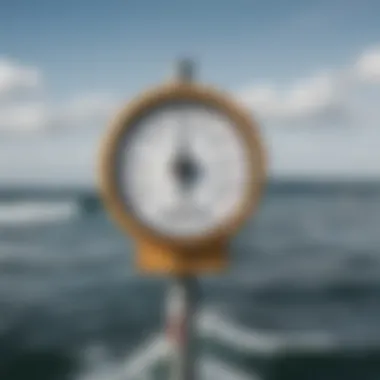
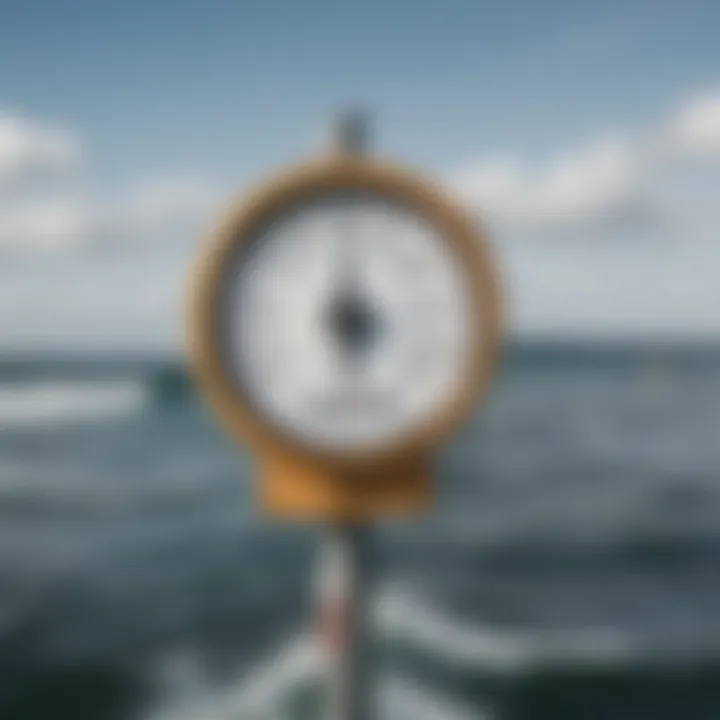
When shopping for that perfect wind direction meter, you'll quickly find octaves of pricing options. But remember, higher cost doesn’t always equate to better performance. Getting the best bang for your buck involves understanding your specific needs. If you’re just a casual kayaker who enjoys an occasional weekend on the water, you might not need a high-end model packed with features that may never see the light of day.
Here, compact models with good basic functionality and decent range may serve you well. However, if you're a competitive sailor or kiteboarder, investing in a premium product that offers the latest tech and exceptional accuracy will yield dividends in performance.
To sum up, regardless of budget, the most effective meters will align with your style, requirements, and the conditions you intend to face. Assessing these factors will greatly inform your choice, enriching your adventures on the water.
Maintenance of Wind Direction Meters
Maintaining wind direction meters is crucial. Just like a trusty sailboat depends on its rigging and sails being in tip-top shape, your wind direction meter must be kept in optimal condition for the best performance. Not taking care of these devices can lead to inaccuracies that might spoil the enjoyment or even compromise safety during exhilarating water activities. Regular maintenance not only extends the lifespan of your instruments but also ensures you receive accurate readings, which is pivotal to making informed decisions while on the water.
Routine Care for Longevity
To keep your wind direction meter in good condition, a routine maintenance schedule is vital. Here are some key practices to follow:
- Cleaning: After every outing, it's wise to clean your device. Saltwater, mud, and other debris accumulate and can interfere with readings. Use a soft cloth and fresh water to wipe it down. For more stubborn grime, a gentle non-abrasive cleaner can help.
- Storage: When not in use, store your device in a dry and shaded location to prevent discoloration or damage from prolonged exposure to sunlight. Consider using a protective case to add an extra layer of defense against impacts.
- Battery Checks: For battery-operated models, always check the battery life before heading out. Replace the batteries regularly, especially if you’ve left the device unused for a while. An unexpected battery failure can lead to readings at the worst possible time.
- Calibration: Ensure that the device is properly calibrated. Depending on the model, you might need to calibrate it periodically following the manufacturer's recommendations. An incorrectly calibrated device may give misleading directions, potentially steering you off course.
By incorporating these simple practices into your routine, you'll keep your wind direction meter functioning effectively for years, providing crucial assistance during your adventures on the water.
Troubleshooting Common Issues
Even with regular maintenance, you might encounter some pesky issues. Here are some common problems and simple troubleshooting steps to try:
- Inaccurate Readings: If you notice that your wind direction meter isn’t giving accurate readings, first check for obstructions. Anything interfering with the wind's path to the sensor can mislead data. Clear the area around the device or reposition it if needed.
- Failed Display: A blank or flickering display might indicate a battery issue. If changing the batteries doesn’t resolve this, inspect the connections for corrosion. Clean any corroded parts gently to restore function.
- Sensitivity Problems: Sometimes, the meter may not respond as quickly as it should to changes in wind direction. This could be due to dirt buildup on the sensor. A thorough cleaning should usually fix this problem.
- Temperature Effects: Be mindful of how extreme temperatures can affect readings. Taking the device from a hot vehicle to a cooler environment can cause condensation inside the unit. A good strategy is to let the device acclimate before use.
"The key to enjoying your time on the water lies in the reliability of your tools." Keep your gear in good shape, and you'll just glide through your adventures.
These troubleshooting steps can help you manage common issues effectively. By addressing them promptly, you’ll be set for many successful days out on the water.
Future Trends in Wind Measuring Technology
In the world of watersports, understanding wind behavior is pivotal, and as technology advances, so too do wind direction meters. It’s not just about having equipment that tells you which way the wind blows; the tools are evolving to provide more precise, user-friendly, and integrated experiences for athletes and enthusiasts alike. This section outlines significant trends shaping the future of wind measuring technology, with a focus on integration with mobile devices and advancements in sensor technology, each offering unique benefits and considerations for users.
Integration with Mobile Devices
The wave of mobile technology is creating a paradigm shift in how athletes monitor wind conditions. Today, many wind direction meters are now engineered to sync seamlessly with smartphones and tablets. This integration means that information can be accessed away from the device and analyzed more intuitively.
- Real-Time Data: This allows athletes to view live wind data while in the water, enabling quicker decision-making. Imagine you're out sailing and can track shifting wind patterns without having to physically check your equipment.
- User-Friendly Interfaces: Mobile apps often come with interactive graphs and charts that simplify the interpretation of wind data.
- Community Features: Many apps encourage social connection among users, offering sharing of conditions and forecasts which can enhance the overall experience. For instance, a kayaker might post current wave conditions to a group chat, benefiting others in the area.
- Data Logging: Users can log conditions over time, providing valuable insights into patterns that enhance performance.
As watersport enthusiasts gear up with these mobile-integrated devices, they benefit from a more holistic view of the wind's behavior, fostering smarter play and safety on the water.
Advancements in Sensor Technology
The era of trial and error in wind forecasting is becoming a thing of the past thanks to rapid advancements in sensor technology. Some key developments that are particularly relevant include:
- Increased Precision: New sensors can detect minute changes in wind speed and direction with an accuracy that was previously unattainable. This type of precision can be a lifesaver for sailors looking to optimize their routes or surfers seeking the perfect wave.
- Smart Algorithms: Enhanced algorithms leverage machine learning to predict wind patterns based on historical data, adapting in real-time to environmental changes. Instead of simply reacting to measurements, these systems are beginning to offer predictive analytics. Imagine gearing up for a kitesurfing session where your gear not only detects conditions but also forecasts the best wind setup.
- Compact and Durable Sensors: Innovations in material science have led to sensors that are lighter and more robust. This is crucial for athletes who demand high performance without adding unnecessary weight to their gear, such as in competitive sailing or colmpetitive freeskate.
- Multi-Functionality: Some new sensors offer additional environmental insights, measuring aspects like humidity and temperature alongside wind direction. This can be very beneficial for kayakers who also have to assess potential storm weather.
"As technology increasingly focuses on having interactive, predictive tools, watersports enthusiasts must adapt to these advancements to enhance their performance and safety on the water."
In the coming years, these trends in wind measuring technology will not only improve accuracy and usability but also redefine the very way athletes interact with their environment. As integration with mobile devices and advancements in sensor technology continue to evolve, the opportunities for optimizing performance in watersports become promisingly clearer.
End
In wrapping up our discussion on wind direction meters, it’s clear that these instruments play a pivotal role in the realm of watersports. The ability to accurately gauge wind direction not only enhances safety but also significantly improves performance across various activities. Understanding how these meters work, coupled with knowledgeable application, allows for better decision-making on the water.
Recapping the Value of Wind Direction Meters
Wind direction meters, such as mechanical vanes, digital anemometers, and smart sensors, provide informed data that is critical for a successful outing on the water. Here are a few key takeaways regarding their value:
- Precision in Navigation: They enable athletes to foresee wind changes, facilitating more precise route planning. This becomes crucial when sailing or kitesurfing, where navigation is often finely balanced on the wind's whims.
- Enhanced Performance: Watersport activities often require micro-adjustments in techniques based on wind speed and direction. For instance, sailboat racers can optimize sail trim by responding instantly to variations in wind, thus gaining an advantage over competitors.
- Safety Assurance: Wind can change in the blink of an eye. Having a reliable wind direction meter aids in avoiding dangerous conditions, especially in open waters where strong gusts can catch even the most seasoned watersports enthusiasts off guard.
- Informed Training: For instructors and athletes alike, these tools provide invaluable data for training. Analyzing wind patterns contributes to fine-tuning skills and strategies.
"Knowledge of wind direction isn't just a piece of information; it's a navigational compass guiding all watersport adventures."
Encouragement for Watersports Enthusiasts
For those chasing the waves or harnessing the wind, remember that the tools you choose to carry can enhance your experience immeasurably. Embrace the technology available and invest in a quality wind direction meter that suits your specific needs, whether you're into surfing, sailing, or kayaking.
Don’t overlook the imperative of constant learning—monitoring wind trends alongside your measurements can significantly heighten your awareness of your surroundings. In doing so, you'll not only navigate the waters more efficiently, but you’ll also deepen your relationship with the very nature that draws you to these activities.
In the end, the joy of watersports lies not just in the thrill but also in the mastery of elements that influence your experience. Equip yourself with the right tools and knowledge. Make each outing an opportunity for growth and skill enhancement. Happy adventuring!















